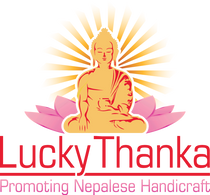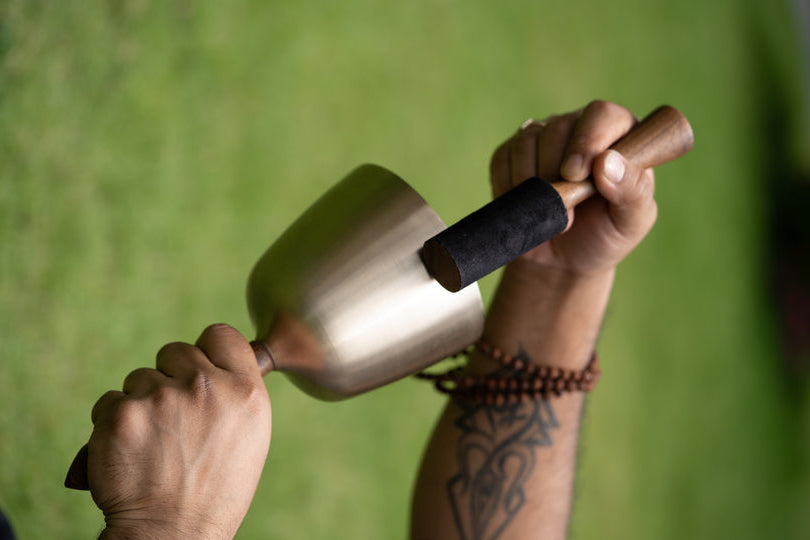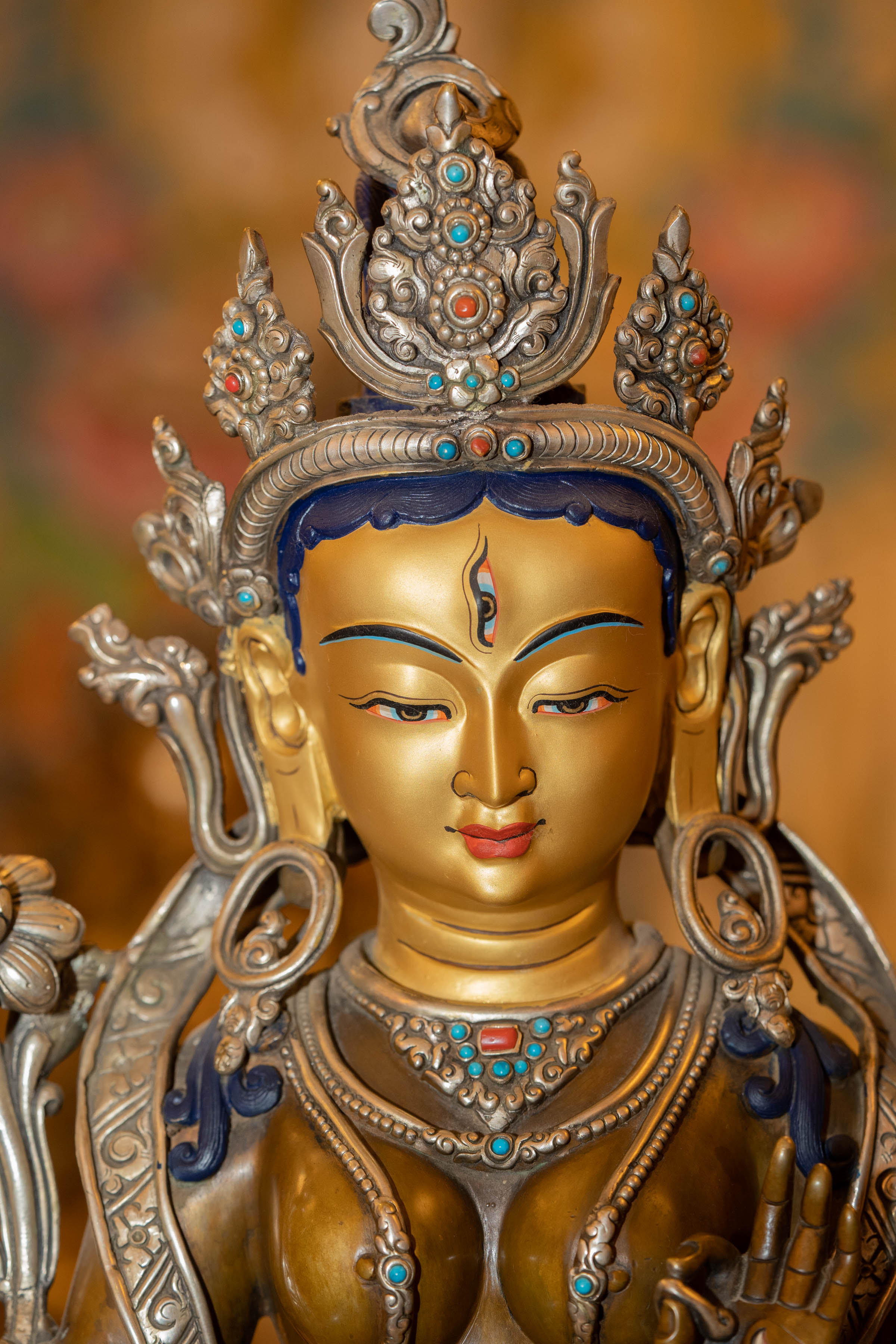Vajra, or Dorje (written as rdo-rje) in the Tibetan language, is a popular symbol in many Buddhist depictions and scriptures. The Vajra is a symbol of indestructibility, strength, and clarity of mind. It represents the unyielding, thunderbolt-like nature of enlightenment and the ability to cut through ignorance and delusion. The Vajra/Dorje is often used in ritual ceremonies and is considered a powerful tool for invoking spiritual power and protection.
The symbol of Vajra is deemed the symbol of the impenetrable, immovable, and indestructible state of enlightenment. This is the general meaning of Vajra.
That said, the meaning of the Vajra Symbol is not limited to this. So, what is the meaning of Vajra?
Let's talk about it.
The General Meaning of the Vajra Symbol

The Vajra represents "male," which symbolizes Upaya or skillful means. In Buddhism, the Vajra symbol represents many things, including but not limited to the diamond-like indestructible, and unchangeable quality of the mind. Additionally, it also symbolizes the unshakeable and powerful nature of enlightenment.
In many depictions, Vajra is also depicted with the bell, which is the female counterpart of the Vajra, symbolizing the Prajna or wisdom. In addition, some Hindu gods are depicted holding Vajra and Bell, which is considered the symbolic gesture of oneness of compassion and wisdom.
Additionally, the Vajra and bell-like the ones from Himalayan Shop are also often used to signify the oneness of compassion and wisdom.
Meaning of Vajra Symbol Based on the prongs

If you carefully look at the symbol of Vajra, you will find that they are not all the same. The vajras are commonly depicted with One, Three, Five, and Ning prongs. Even among these depictions, the most common Vajra you can find is the five-pronged. Their meaning can also vary depending on the number of prongs on a Vajra.
Following are the meanings of the four major types of Vajra:
A) Meaning of Single Pronged Vajra Symbol
This symbol of Vajra represents the central channels at Mount Meru's central air. The single prong on this symbolism of Vajra represents a union of all the dualities, which includes but is not limited to :
- the duality of wisdom and compassion
- emptiness and bliss
- relative and ultimate truths
Note: Mount Meru is a sacred Five peaked mountain in Hinduism, Buddhism, and Jainism that is considered the center of all the physical, metaphysical, and spiritual universes
B) Meaning of three Pronged Vajra Symbol
This symbol of Vajra represents three different aspects. The first aspect represented by the three-pronged Vajra is the trinity of time, which includes the past, present, and future. Another aspect that the three-pronged Vajra represents is the three Kayas of the body: Sambhogakaya, Nirmanakaya, and Dharmakaya.
Kayas directly translates to the body but can often mean dimensions of or basis of a body, and the three kayas represented by the Three-pronged Vajra symbol mean:
- Sambhogakaya: The body of Enjoyment
- Nirmanakaya: Body of Manifestation
- Dharmakaya: Body of Truth
The three-pronged vajra symbol's third aspect is the three gates, i.e., Body, Speech, and Mind.
C) Meaning of five Pronged Vajra Symbol
Five-pronged Vajra is the most common type of Vajra, and the five prongs of this Vajra represent the five pearls of wisdom that one can attain through the transcendence of the five kleshas. Kleshas in Buddhism are mental states that are attained through unholy actions, and the five Kleshas represented by the five-pronged vajra symbols are:
- Greed
- Anger
- Delusion
- Pride
- Envy
This vajra symbol also represents the five cosmic directions' five buddhas, namely Vairochana, Amitabha, Ratnasambhava, Amoghasiddhi, and Akshobhya.
Five pronged Vajra symbol also represents the five kayas of the Anutttarayogyta Tantra. Besides the ones we previously mentioned, the two additional kayas are:
- Vajrakaya: Body of the unchanging natural state
- Abhisambodhikaya: Body of complete awakening
D) Meaning of Nine Pronged Vajra Symbol
The Nine-pronged Vajra represents the buddhas of the five cardinal directions along with the four mothers who are Lochana, Manki, Pandara, and Tara. This vajra symbol also symbolizes the nine vehicles of Vajrayana, which are:
- Shravaka Yana
- Pratyekabuddha Yana
- Bodhisattva Yana
- The yana of Kriya tantra
- The yana of Charya tantra
- The yana of Yoga tantra
- The yana of Mahayoga
- The yana of Anuyoga
- The yana of Atiyoga
Besides these four common types of Vajra, there is another type of Vajra that you may have noticed.
E) Meaning behind the symbol of Crossed Vajra symbol:
The crossed Vajra or VishvaVahra is a double Vajra. The connecting point of the Vajra represents the foundation of the Universe of Mount Meru. This vajra symbol also represents/ means the principle of absolute stability and is characterized as the solidity of mother earth.
Along with this, you can also find four swastika signs on each corner of the crossed vajra. In Vajrayana Buddhism, the swastika symbolizes the element of the earth and its stability. That said, the meaning of Vajra changes a bit when they are depicted in Thangka (Thanka).
What is the meaning of the Vajra Symbol when depicted in Thangka?

Thangka (Tangka, Thanka, or Tanka) is a Tibetan Buddhist art form depicting Buddhist deities or mythological events on a cotton canvas. Because the depictions are primarily Buddhist deities and other mythological events, the depiction of Vajra is common.
The Vajra in this art form is depicted in different forms as a hand ornament or as a crown ornament, depending on the deities.
Depiction of five and nine-pronged Vajra Symbol in Thangka
In this Tibetan art form, five- and nine-pronged Vajra are depicted similar to each other. The only difference between them is that five-pronged Vajra is depicted with closed ends while nine-pronged Vajra is depicted with open ends.
In general, the five and nine-pronged Vajra are depicted in gold. However, sometimes they are depicted in deep blue if an extremely wrathful deity holds the Vajra. The meaning of the vajra symbol does not change regardless of the color.
Depiction of the crossed Vajra and the meaning behind the symbol
Unlike the five-pronged and nine-pronged Vajra, the symbolism and meaning change slightly from the general meaning. In thangka, the Vishvavajra is depicted in the five colors of the Buddha Mandala, with each color representing the five cardinal directions. The colors and the cardinal direction that they represent are:
- Blue: Central
- White: East
- Yellow: South
- Red: West
- Green: Green
VishvaVajra is generally depicted as a three-pronged Vajra in a flat tangka art. This totals up to twelve prongs, and each of these prongs in the representation of the Vajra Symbol means the twelve great deeds of the Shakyamuni Buddha. These deeds are:
- The descent of lord Buddha from Tushita Heaven
- Entry of the buddha into his mother's womb
- The birth of lord Buddha
- His mastery of skills and arts
- The marriage of lord buddha, along with the birth of his child
- The renunciation of all the worldly wealth of lord Buddha
- Lord buddha practicing austerities
- Meditation of lord Buddha under the Bodhi Tree
- Him conquering the Evil Mara
- His attainment of Enlightenment
- The turning wheel of Dharana
- The final Parinirvana of lord Buddha
That said, both the depiction/ symbol in Thangka and the real Vajra share the same meaning of stability.
Some Buddhist deities holding Vajra with its Spiritual meaning:
Although the core of the symbol remains the same, i.e., a powerful weapon that aids in the destruction of evil, the spiritual meaning of the vajras changes slightly depending on the depiction of deities that hold the Vajra. Some Buddhist deities holding Vajra and their spiritual meanings are as follows.
Vajrasattva

Vajrasattva is a bodhisattva in Vajrayana Buddhism that embodies the qualities of purification and cleansing of negativities. The name "Vajrasattva" translates to "diamond being" or "indestructible being," and he is considered an embodiment of the primordial purity and unchanging nature of the mind.
Vajrasattva is often visualized in Vajrayana practice as a white-colored deity, holding a vajra and a bell in his hands and seated on a lotus throne. The vajra in his hands symbolizes his ability to cut through and purify obscurations, delusions, and negative karma. Additionally, the vajra in Vajrasattva's hand can represent the union of skillful means and wisdom, which are the two essential aspects of Buddhist practice.
Vajrayogini

Vajrayogini is a Tantric Buddhist deity in the Vajrayana tradition that is associated with the practice of Chakrasamvara. She is often depicted as a wrathful, red-colored, dancing deity adorned with human skulls and other symbolic ornaments. In Vajrayana practice, Vajrayogini is considered to be the embodiment of the realization of emptiness and the union of wisdom and skillful means.
The Vajra in the hands of Vajrayogini has several spiritual meanings. The vajra in the hands of Vajrayogini represents the powerful and transformative nature of her practice, which is focused on the realization of emptiness and the awakening of inner wisdom. Additionally, the vajra in the hands of Vajrayogini also represents her power to cut through delusions and obstacles that prevent sentient beings from reaching the state of enlightenment.
Vajrapani

Vajrapani is often depicted as a wrathful deity with a blue or green body, one or multiple heads, multiple arms, and a fierce expression. He is typically depicted holding a vajra (thunderbolt) in one hand and a lasso in the other,
The vajra in the hands of Vajrapani symbolizes his ability to vanquish obstacles and cut through delusions with the power of skillful means. Along with this, the Vajra in the hands of Vajrapani also represents his unwavering commitment to the path of enlightenment. It also represents the extreme clarity and true indestructible nature of reality, which Vajrapani helps to reveal and embody.
Guru Rinpoche

Guru Rinpoche (Padmasambhava) is a legendary figure in Vajrayana Buddhism who is widely revered as the "second Buddha." He is credited with introducing Buddhism to Tibet in the 8th century and is regarded as the founder of the Nyingma school of Tibetan Buddhism. Guru Rinpoche is often depicted as a peaceful, loving, and compassionate deity and is one of the central figures in Vajrayana Buddhism.
The vajra in the hands of Guru Rinpoche symbolizes his mastery of the Vajrayana path and his ability to subdue and transform negative energies and obstacles into positive qualities and enlightened activity. It also represents the indestructible and unchanging nature of emptiness, which is the ultimate nature of everything, as per Buddhist philosophy.
In the end,
In conclusion, the vajra is a powerful symbol that represents the indestructible and unchanging nature of an enlightened mind. Vajra or Dorje is often depicted as a diamond-shaped object with a central sphere and two sets of prongs. Each set can contain a different number of prongs depending on the depiction. The meaning of the vajra symbol often depends on the number of prongs on each set of Vajra. Additionally, the meaning of the Vajra symbol also depends on the deity holding the vajra.
FAQ:
Q: What is vajra used for?
A: Mythically, Vajra is a throwing weapon used by Vajrapani to stum the victim, who is later bound with the Vajra lasso held in his hands.
Q: What is the symbolism of double Vajra?
A: The Double Vajra or Vishvavajra means the principle of absolute stability. Furthermore, the twelve prongs also signify the twelve great deeds of Shakyamuni Buddha.
Q: What does the three-pronged Vajra mean?
A: The three-pronged Vajra means the trinity of time, the three kayas of body, and the three gates.
Q: What does a vajra look like?
A: The Vajra looks like two-sided tridents with prongs at the ends of the shaft. Each side's total number of prongs can differ from one, three, five, or nine.
Q: Why is Vajra so powerful?
A: The Vajra is considered the weapon of lord Indra, who is the Vedic king of Devas and heaven. This weapon represents the firmness of spirit and spiritual power. Because of these reasons, Vajra and vajra symbols are considered powerful.
Q: What does Vajra mean in Buddhism?
A: In Buddhism, the Vajra is the symbol of indestructibility and immutability.
Q: What is the meaning of the Vajra Symbol?
A: Vajra is the symbol of the Vajrayana (Diamond Vehicle) Path of Buddhism, and in Sanskrit, this symbol means Hard or mighty.



